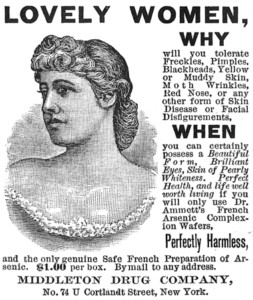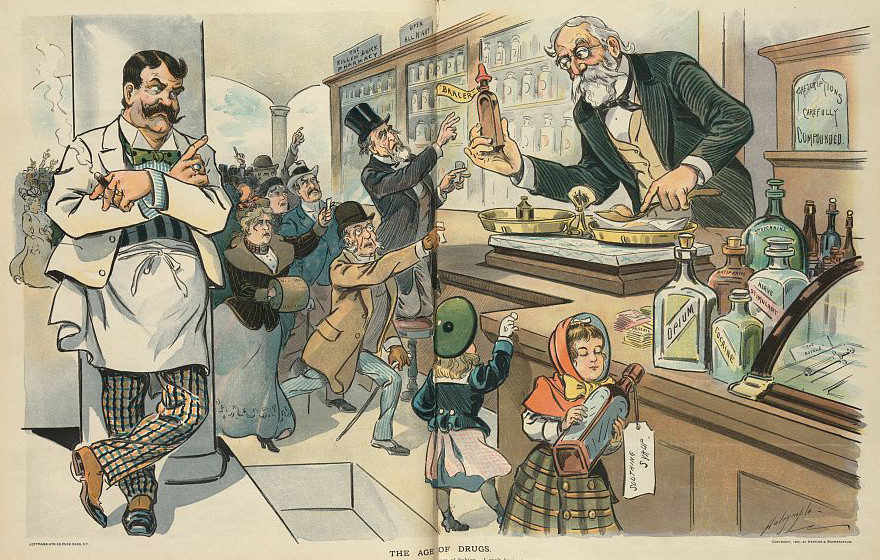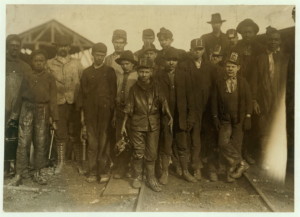Victorian Killers
Did you Know…
If you’re thinking this blog is about Lizzy Borden, Jack the Ripper, or Arizona’s own Winnie Ruth Judd, think again! There were things in every day life during the 19th century that were more dangerous to many more people than were affected by those notorious murderers.

What was it that was so dangerous? You be the judge! Here’s a list of commonplace things from Victorian Era life that sickened, injured, and even killed people:
-
-
- Water – With no regulations about dumping waste or chemicals, drinking water was often contaminated with things we’d rather not think about. Polluted water caused outbreaks of dysentery and cholera, particularly in poorer areas. Closer to home, lead pipes were often used to convey water into people’s homes, causing permanent brain and nervous system damage to children, high blood pressure and kidney damage in adults, and miscarriage and stillbirth for pregnant women (World Health Organization).
-
- Food – Again with the regulations! Manufactured food could be mixed with anything from alum or arsenic to plaster of Paris. Nonfood additives caused severe problems with malnutrition, like rickets and scurvy, not to mention painful gastrointestinal issues. There were no laws that provided for the safe processing of meats and other foods, and lack of pasteurization of raw milk often led to contamination with bovine tuberculosis (which caused damage of internal organs, severe spinal deformities, and death in children). Read The Jungle by Upton Sinclair for more fun stories about turn-of-the-century food processing and job hazards.

A Victorian Era wallpaper sample dyed with arsenic from Shadows from the Walls of Death by Dr Robert C Kedzie, 1874.
- Your House – Water pipes were made of lead, and many things inside your house could be painted with lead or even asbestos paint (including your children’s toys). Wallpaper* was treated and colored with commercial dyes that could include poisons like picric acid and arsenic, which would later be released into the air in hot (uh oh, Phoenix!) and humid climates. Clothing also had these same harmful dyes, to make them colorful and colorfast, which would leach into your skin when you wore them. If you weren’t getting enough arsenic from your wallpaper or clothes, you could take arsenic pills that were supposed to enhance your complexion (see ad below), creating a “youthful pallor”. You could also use baby powder that contained arsenic. Sufferers of arsenic poisoning would have acute abdominal and esophageal pain, vomiting and diarrhea, and heart problems (if you lived long enough to have them). *To be clear, the Rosson House wallpaper was recreated on the patterns and not the materials used in 1895.
- Food – Again with the regulations! Manufactured food could be mixed with anything from alum or arsenic to plaster of Paris. Nonfood additives caused severe problems with malnutrition, like rickets and scurvy, not to mention painful gastrointestinal issues. There were no laws that provided for the safe processing of meats and other foods, and lack of pasteurization of raw milk often led to contamination with bovine tuberculosis (which caused damage of internal organs, severe spinal deformities, and death in children). Read The Jungle by Upton Sinclair for more fun stories about turn-of-the-century food processing and job hazards.
-
- Healthcare – At this time, doctors were often doing as much harm as they were good. They were not consistently washing their hands or sanitizing their medical instruments, leading to high rates of infection in their patients. Without antibiotics, infection (or blood poisoning) was a frequent killer. President Garfield was more a victim of his doctors’ unclean hands then he was his assassin’s bullet.
 Diseases like measles, mumps, diphtheria, rubella, pertussis, smallpox, and influenza were particularly virulent. Influenza killed an estimated 50 million people worldwide by the end of World War I (CDC). As with infections, doctors simply didn’t yet have the modern medicines to fully vaccinate people and prevent many of these deaths. And if infections and diseases weren’t bad enough, doctors were treating people with medicines that contained arsenic, mercury, strychnine, opium, cocaine, heroin, and who knows what else (see picture in heading, Puck Magazine, October 1900). Like with everything else at this time, lack of regulations made even taking medicine prescribed by your doctor hazardous to your health.
Diseases like measles, mumps, diphtheria, rubella, pertussis, smallpox, and influenza were particularly virulent. Influenza killed an estimated 50 million people worldwide by the end of World War I (CDC). As with infections, doctors simply didn’t yet have the modern medicines to fully vaccinate people and prevent many of these deaths. And if infections and diseases weren’t bad enough, doctors were treating people with medicines that contained arsenic, mercury, strychnine, opium, cocaine, heroin, and who knows what else (see picture in heading, Puck Magazine, October 1900). Like with everything else at this time, lack of regulations made even taking medicine prescribed by your doctor hazardous to your health.
- Healthcare – At this time, doctors were often doing as much harm as they were good. They were not consistently washing their hands or sanitizing their medical instruments, leading to high rates of infection in their patients. Without antibiotics, infection (or blood poisoning) was a frequent killer. President Garfield was more a victim of his doctors’ unclean hands then he was his assassin’s bullet.
-
This is by no means a complete list of the dangers of living during the Victorian Era. Childbirth was dangerous – there were 8 to 10 maternal deaths for every 1,000 births around the turn-of-the-century, something that didn’t change until advancements like antibiotics, sterilization of instruments, and blood transfusions became the norm (Our World in Data). Having a job was dangerous – particularly jobs like those in the Triangle Shirtwaist Factory, and particularly for children who worked in dangerous industries, like the young miners in the picture below, where even breathing was dangerous due to coal dust. In all, 19th century life was challenging, difficult, and, in so many cases, deadly.
Read our blog about how schools were affected by then-commonplace diseases like smallpox and even the 1918 influenza pandemic at the turn-of-the-century.
We found information for this article from the Maryland Historical Society blog ; the Smithsonian Magazine; Shadows from the Walls of Death, by Dr Robert C Kedzie (1874); the Internet Archive, the Science History Institute, and The Atlantic.
-
2025
-
January (1)
-
-
2024
-
December (1)
-
November (1)
-
October (1)
-
September (1)
-
August (1)
-
July (1)
-
June (1)
-
May (1)
-
April (1)
-
March (1)
-
February (1)
-
January (1)
-
-
2023
-
December (1)
-
November (1)
-
October (1)
-
September (1)
-
August (1)
-
July (1)
-
June (1)
-
May (1)
-
April (1)
-
March (1)
-
February (1)
-
January (1)
-
-
2022
-
December (1)
-
November (1)
-
October (1)
-
September (1)
-
August (1)
-
July (1)
-
June (1)
-
May (1)
-
April (1)
-
-
2021
-
December (1)
-
November (1)
-
October (1)
-
September (1)
-
August (1)
-
July (1)
-
June (1)
-
May (1)
-
April (1)
-
March (1)
-
February (1)
-
January (1)
-
-
2020
-
December (1)
-
November (1)
-
October (1)
-
September (1)
-
August (1)
-
July (1)
-
June (1)
-
May (1)
-
April (1)
-
March (1)
-
February (1)
-
January (1)
-
-
2019
-
December (1)
-
November (1)
-
October (1)
-
September (1)
-
August (1)
-
July (1)
-
June (1)
-
May (1)
-
April (1)
-
March (1)
-
February (1)
-
January (1)
-
-
2018
-
December (1)
-
November (1)
-
October (1)
-
September (1)
-
August (1)
-
July (1)
-
May (1)
-
April (1)
-
March (1)
-
February (1)
-
January (1)
-
-
2017
-
December (1)
-
November (1)
-
October (1)
-
September (1)
-
August (1)
-
July (1)
-
June (1)
-
May (1)
-
April (1)
-
March (1)
-
February (1)
-
-
2016
-
December (1)
-
-
2015
-
2014
-
July (1)
-

